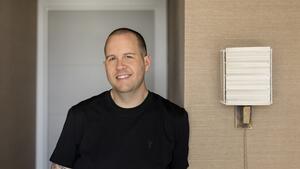To state the obvious: The coronavirus pandemic is far from over. However, more than six months in, the design industry is certainly in a different place. The ambient panic is humming at a much lower volume. Delays and logjams in the supply chain are being ironed out. And on a purely positive note, Americans have become obsessed with their homes.
A perfect time then to check in on makers and manufacturers. Six months ago, the Business of Home podcast touched base with three business leaders—Sara Fritsch, president of Portland, Oregon–based lighting and home brand Schoolhouse Electric; Jonathan Glatt, co-founder and creative director of Rhode Island–based workshop O&G Studio; and Andrew Crone, president and CEO of North Carolina furniture maker Chaddock—to find out how they were dealing with the early days of the pandemic. On the latest episode of the show, host Dennis Scully catches up with them to find out what their world looks like now.
All three have seen the residential side of their business boom in recent months, as shelter-in-place orders have led to a spike in renovation and redecoration projects. All three have discovered new things about their business—efficiencies that weren’t there before, the importance of better e-commerce tools, a heightened sense of camaraderie—that they’ll carry forward beyond the masks and handwashing. None of them are feeling completely certain that they’re out of the woods yet.
“The demand is definitely there,” says Fritsch. “But we don’t know what’s around the corner.”
Listen to the episode and check out some takeaways below. If you like what you hear, subscribe to the podcast here. This episode was sponsored by Resource Furniture and Universal Furniture.
Success in Streamlining
Very few cities have had a more tumultuous 2020 than Portland. First, a pandemic. Then, violent clashes between protestors and federal troops. To top things off, record-setting wildfires displaced tens of thousands of people throughout the state. So it’s no surprise that Fritsch is keeping a conservative mindset, even though demand has picked up significantly since the dark days of mid-April.
One of the biggest business changes Schoolhouse has made is an investment in a better e-commerce system and more efficient backend processes—the company is now a leaner operation. Though Fritsch notes that the residential side of the business (especially textiles) has been buzzing recently, she thinks we will see things like travel and hospitality bounce back with a vengeance when it’s safe. For now, however, she’s riding the wave. “Even with that, people have rethought what home means to them, why it matters, and I bet we’ll see 2021 build on those learnings,” she says. “We are definitely focused on the continuation of this upswing—the future’s very bright.”
People come first
When Glatt joined the podcast in April, his Rhode Island furniture workshop was closed down due to shelter-in-place. Since then, he was able to reopen, and immediately faced a backlog of 300 pieces, all of which needed to be made by hand. O&G is through the backlog now, and has seen sales in August and September up 40 percent over 2019. One of Glatt’s biggest takeaways from the shutdown was a renewed focus on team spirit and the way his staff came together to get through a dark time. “You look at all the equipment in your factory and think of all things that can be done here, but when they’re quiet, what you realize is, no matter how many tools, these places really are about the people,” he says. “Coming through this all together and realizing there’s a shared goal really deepened the trust. … We just had a conversation the other day where someone said, ‘Before, when someone would tell me: “Hey, what you did there didn’t turn out great,” what I heard was: “You’re a terrible person.” What I realize now is that’s just an objective observation and we’re all trying to do better.’”
Capitalizing on the Surge
Like most furniture brands, North Carolina maker Chaddock has seen its commercial business drop off considerably. However, the residential work is more than making up for it, says Crone. “The industry was predicting—and I think we all hoped this would be true—but we’re actually seeing people spend more time at home and looking for a refresh,” he says. “There’s more discretionary income that’s not being spent on vacations, fine dining or that expensive gym membership.” He says Chaddock is leaning into this period, hiring more workers, and spending to build out its digital presence with the goal of maximizing the surge of demand for home furnishings.
Homepage photo: Shutterstock






























